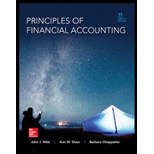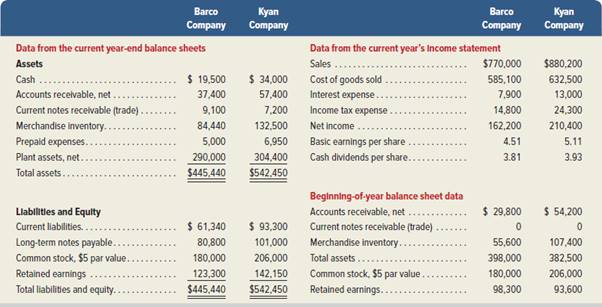
Comparative ratio analysis
Summary information from the financial statements of two companies competing in the same industry follows.

Required
- 1. For both companies compute the (a)
current ratio , (b) acid-test ratio, (c) accounts (including notes) receivable turnover, (d) inventory turnover, (e) days’ sales in inventory, and (f) days’ sales uncollected. Identify the company you consider to be the better short-term credit risk and explain why. Round to one decimal place.
Check (1) Kyan:
- 2. For both companies compute the (a) profit margin ratio, (b) total asset turnover, (c) return on total assets, and (d) return on common stockholders’ equity. Assuming that each company’s stock can be purchased at $75 per share, compute their (e) price-earnings ratios and ( f) dividend yields. Round to one decimal place. Identify which company’s stock you would recommend as the better investment and explain why.
(2) Barco: Profit margin, 21.1%; PE, 16.6
1.
Compute the (a) current ratio, (b) acid-test ratio, (c) accounts (including notes) receivable turnover, (d) inventory turnover, (e) days’ sales in inventory, and (f) days’ sales uncollected of Company F and Company B and identify the company that would the better on terms of short-term credit risk and explain the reasons.
Explanation of Solution
- a) Current ratio: Current ratio is one of the liquidity ratios, which measures the capacity of the company to meet its short-term obligations using its current assets. Current ratio is calculated by using the formula:
- b) Acid-test ratio: It is a ratio used to determine a company’s ability to pay back its current liabilities by liquid assets that are current assets except inventory and prepaid expenses.
- c) Accounts receivables turnover ratio: Receivables turnover ratio is mainly used to evaluate the collection process efficiency. It helps the company to know the number of times the accounts receivable is collected in a particular time period. This ratio is determined by dividing credit sales and average net receivables.
- d) Inventory Turnover Ratio: This ratio is a financial metric used by a company to quantify the number of times inventory is used or sold during the accounting period. It is calculated by using the formula:
- e) Days’ sales in inventory: Days’ in inventory is determined as the number of days a particular company takes to make sales of the inventory available with them.
- f) Days’ sales uncollected: This ratio is used to determine the number of days a particular company takes to collect accounts receivables.
Compute ratios of Company B and Company K:
| Ratios | Company B | Company K | |
| (a) Current ratio | |||
| Cash | $19,500 | $34,000 | |
| Accounts receivables, net | $37,400 | $57,400 | |
| Current notes receivable (trade) | $9,100 | $7,200 | |
| Merchandise inventory | $84,440 | $132,500 | |
| Prepaid expenses | $5,000 | $6,950 | |
| Current assets (A) | $155,440 | $238,050 | |
| Current liabilities (B) | $61,340 | $93,300 | |
| Current ratio | 2.5:1 | 2.6:1 | |
| (b) Acid-test ratio | |||
| Cash | $19,500 | $34,000 | |
| Accounts receivables, net | $37,400 | $57,400 | |
| Current notes receivable (trade) | $9,100 | $7,200 | |
| Quick assets (C) | $66,000 | $98,600 | |
| Current liabilities (D) | $61,340 | $93,300 | |
| Acid-test ratio | 1.1:1 | 1.1:1 | |
| (c) Accounts (including notes) receivables turnover ratio | |||
| Accounts receivables, net (E) | $29,800 | $54,200 | |
| Current notes receivable (trade) (F) | $0 | $0 | |
| Total beginning net accounts (including notes) receivables (G) | $29,800 | $54,200 | |
| Accounts receivables, net (H) | $37,400 | $57,400 | |
| Current notes receivable (trade) (I) | $9,100 | $7,200 | |
| Total ending net accounts (including notes) receivables (J) | $46,500 | $64,600 | |
| Average net accounts (including notes) receivables (K) | $38,150 | $59,400 | |
| Net credit sales (L) | $770,000 | $880,200 | |
| Accounts (including notes) receivables turnover ratio | 20.2 times | 14.8 times | |
| (d) Inventory turnover ratio | |||
| Ending inventory (M) | $84,440 | $132,500 | |
| Beginning inventory (N) | $55,600 | $107,400 | |
| Average inventory (O) | $70,020 | $119,950 | |
| Cost of goods sold (P) | $585,100 | $632,500 | |
| Inventory turnover ratio | 8.4 times | 5.3 times | |
| (e) Days’ sales in inventory | |||
| Ending inventory (Q) | $84,440 | $132,500 | |
| Cost of goods sold (R) | $585,100 | $632,500 | |
| Days’ sales in inventory | 52.7 days | 76.5 days | |
| (f) Days’ sales uncollected | |||
| Ending Accounts receivables, net (S) | $37,400 | $57,400 | |
| Ending Current notes receivable (trade) (T) | $9,100 | $7,200 | |
| Total ending net accounts (including notes) receivables (U) | $46,500 | $64,600 | |
| Net credit sales (V) | $770,000 | $880,200 | |
| Days’ sales uncollected | 22.0 days | 26.8 days | |
Table (1)
Short term credit risk analysis: As per Table (1) the current ratio of Company K is slightly better than the current ratio of Company B. The acid-test ratios of both the companies are same. The accounts turnover and the inventory turnover of Company B are better than the ratios of Company F. However, the day’s sales in inventory and the day’s sales uncollected of Company F are 76.5 days and 26.8 days respectively, that are higher than the ratios of Company B. Hence, Company B is better in managing the short term credit risk.
2.
Compute the (a) profit margin ratio, (b) total asset turnover, (c) return on total assets, (d) return on common stockholders’ equity, (e) price earnings ratio, and (f) dividend yields of Company F and Company B and identify the company that could be recommended as better investment and explain the reasons.
Explanation of Solution
- a) Profit margin: It is one of the profitability ratios. Profit margin ratio is used to measure the percentage of net income that is being generated per dollar of revenue or sales.
- b) Total asset turnover: Total asset turnover is a ratio that measures the productive capacity of the total assets to generate the sales revenue for the company. Thus, it shows the relationship between the net sales and the average total assets. Turnover of assets is calculated as follows:
- c) Return on total assets: Return on total assets is the financial ratio that determines the amount of net income earned by the business with the use of total assets owned by it. It indicates the magnitude of the company’s earnings with relative to its total assets. Return on investment is calculated as follows:
- d) Return on common stockholders’ equity ratio: It is a profitability ratio that measures the profit generating ability of the company from the invested money of the shareholders. The formula to calculate the return on equity is as follows:
- e) Price/Earnings Ratio: The price/earnings ratio shows the market value of the amount invested to earn $1 by a company. It is major tool used by investors for making decisions related to the investment in a company.
- f) Dividend yields: Dividend yield ratio indicates how much percentage of share prices a company pays out in the form of dividends price. The formula to calculate the dividend yield percentage is as follows:
Compute ratios of Company B and Company K:
| Ratios and Formula | Company B | Company K |
|
a. Profit margin: | ||
|
b. Total asset turnover: | ||
|
c. Return on total assets: | ||
|
d. Return on common stockholders’ equity: | ||
|
e. Price-earnings ratio: | ||
|
f. Dividend yield: |
Table (2)
Investment analysis: As per Table (2) the profitability ratios of Company K is higher than the ratios of Company B. However, the price earnings ratio of Company B is higher than Company K, but the dividend yield of Company K is higher than Company B. Hence, Company K is a better investment option.
Working Note:
Determine the average total assets and average common stockholders’ equity.
| Ratios and Formula | Company B | Company K |
|
a. Average total assets: | ||
|
b. Average common stockholders’ equity: |
Table (3)
Want to see more full solutions like this?
Chapter 17 Solutions
Principles of Financial Accounting.
- Reffering to fair value of an asset, division, or organization, What exactly is fair value and how is it assessed?arrow_forwardThe following transactions involving intangible assets of Oriole Corporation occurred on or near December 31, 2025. 1.) Oriole paid Grand Company $520,000 for the exclusive right to market a particular product, using the Grand name and logo in promotional material. The franchise runs for as long as Oriole is in business. 2.) Oriole spent $654,000 developing a new manufacturing process. It has applied for a patent, and it believes that its application will be successful. 3.) In January 2026, Oriole's application for a patent (#2 above) was granted. Legal and registration costs incurred were $247,800. The patent runs for 20 years. The manufacturing process will be useful to Oriole for 10 years. 4.) Oriole incurred $168,000 in successfully defending one of its patents in an infringement suit. The patent expires during December 2029. Oriole incurred 5.) $446,400 in an unsuccessful patent defense. As a result of the adverse verdict, the patent, with a remaining unamortized cost of…arrow_forwardNonearrow_forward
- I need help solving this general accounting question with the proper methodology.arrow_forwardI need help with this general accounting question using the proper accounting approach.arrow_forwardPlease provide the correct answer to this general accounting problem using valid calculations.arrow_forward
- Can you explain the correct methodology to solve this general accounting problem?arrow_forwardCan you solve this general accounting question with the appropriate accounting analysis techniques?arrow_forwardCan you solve this general accounting problem using appropriate accounting principles?arrow_forward
 Cornerstones of Financial AccountingAccountingISBN:9781337690881Author:Jay Rich, Jeff JonesPublisher:Cengage LearningPrinciples of Accounting Volume 1AccountingISBN:9781947172685Author:OpenStaxPublisher:OpenStax College
Cornerstones of Financial AccountingAccountingISBN:9781337690881Author:Jay Rich, Jeff JonesPublisher:Cengage LearningPrinciples of Accounting Volume 1AccountingISBN:9781947172685Author:OpenStaxPublisher:OpenStax College Financial AccountingAccountingISBN:9781337272124Author:Carl Warren, James M. Reeve, Jonathan DuchacPublisher:Cengage LearningCentury 21 Accounting Multicolumn JournalAccountingISBN:9781337679503Author:GilbertsonPublisher:Cengage
Financial AccountingAccountingISBN:9781337272124Author:Carl Warren, James M. Reeve, Jonathan DuchacPublisher:Cengage LearningCentury 21 Accounting Multicolumn JournalAccountingISBN:9781337679503Author:GilbertsonPublisher:Cengage





